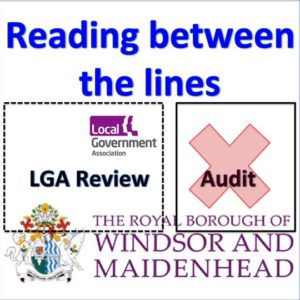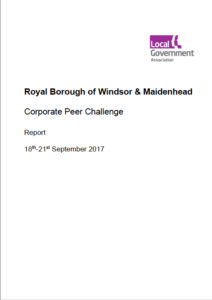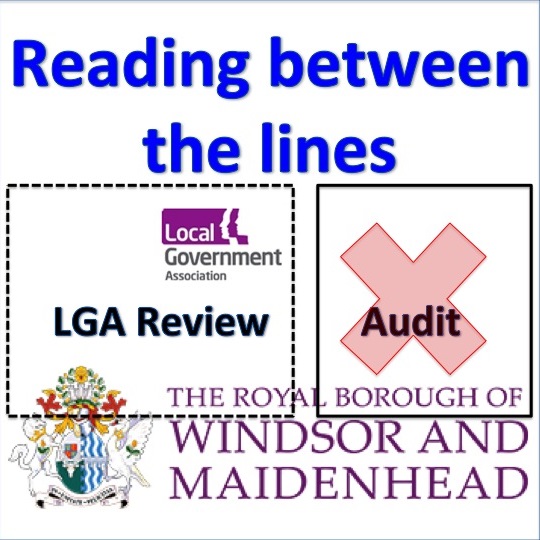Stripping away the spin & code, WWRA Cllr. Wisdom Da Costa highlights key aspects of the LGA Peer Review report; empowering people; reading between the lines

RBWM invited the Local Government Association to review certain aspects of the Council’s operations. The LGA’s Peer Group review report was released to the public on 25 October 2017
It is important that the Peer Group review is seen for what it is; a report by a friend and not a critical Audit or Inspection. As such, it does not question the political policy followed by the Council, as that is a matter for the electorate to choose at the ballot box. However, it correctly focuses on process to achieve the chosen political ideology.
With that in mind, when you dig beneath the surface, the detailed comments and the 25 recommendations are actually damning, but recognise that a positive change in culture is possible, though some would say unlikely.
Conclusions
As a friendly, supportive, review, the LGA Peer Review report is damning of the Council’s poor processes and culture which increases risks, puts officers under duress, unfairly treats people, frustrates scrutiny (democracy) and, ignores residents (some of its key reasons for existence).
However, it does give the Conservative led Council the chance to redeem itself; a chance for the Council to put residents first and to focus the Council machinery and resourcing to achieving that.
Let’s hope that this leopard does change its spots. If not, residents can take action at the next elections in May 2019 to bring in more Councillors who will put people first.
The council’s governance is out of date…
Key concerns noted in the report
The report “highlights” many areas of concern including, inter alia, the following;
- “The council’s governance is out of date”
- “We were concerned to see evidence of…disproportionate and uneven treatment by senior colleagues, of both members and officers…(using)… heavy handed instrument to keep ‘members and officers incheck’.”
- A need, “to clarify lines of accountability”
- “Lines between the Executive and scrutiny (are) blurred”
- “Scrutiny not realising its potential” – how polite.
- “Officer support capacity is largely limited… leaving the council exposed to risk”
- “Businesses not feeling valued as a partner”
- Questions the ability, “to deliver on its capital programme and regeneration plans.”
- Asks the council “to carefully plan for the provision of any future transformation costs”
- Notes a “need to invest more time and capacity in equipping your organization”
- Earnestly urges the Council to “Invest more time in understanding what your residents value” & ”engage positively with residents and community groups.”
NB It is also worth noting that the views of residents, residents groupings and parish councils “are not reflected in this report” of the LGA, which perhaps took the edge off the recommendations made.
to put people first

What people want from their Council
It strikes me that the key reasons for a Council’s existence are to put people first;
- To put residents as the heart and focus of its objectives
- To equip & empower staff who are the core of the service
- To embed high quality scrutiny to ensure good governance and to uphold the democratic process
*Though I would also add the environment and ecosystem to that list.
With this in mind, the 25 detailed recommendations (noted below) highlight major areas for improvement in all three of these key areas though more politely worded this in their three main recommendations
[box]
Pause. Embed. Explain
LGA Peer Review Groups three main recommendations (PEE)
- “Pause: now is the moment to pause on the change you have focused on designing and delivering. This does not mean stop improving services, but will allow you time to;
- Embed: establish and share with all partners clear lines of accountability for council service areas, whether commissioned or directly provided and clarity over the location of statutory roles (Director of Children’s Services, Director of Adult Social Care and Director of Public Health).Ensure these are widely understood. Consolidate the good services that you have without seeking further immediate change. Where services fall short of expectation identify clear pathways for improvement and ownership for who is accountable for that improvement. Refresh your governance to help you underpin this;
- Explain: the organisation, its partners and the residents of the Royal Borough need to better understand the changes that are taking place – and why. The new operating model is not widely understood by staff and the residents that we spoke to. By investing more time in explaining what changes have taken place, and why, you will be able to reflect upon their success and consider how the borough can best deliver high performing services and value for money. This will also be an opportunity for you to build and further deepen trust between yourselves and all of your
Having implemented the three key recommendations actively promote, to all parties a single vision for the borough – bringing together your ambitions for people and place.”
[/box]

Summary of the 25 detailed recommendations
Click here to read recommendations in full
- “Undertake a full Constitutional review – led at the most senior officer level, supported by (3 suggestions)
- Introduce a process map to clarify lines of accountability for all commissioned and contracted out services. This should be developed by members and officers and accompanied by a clear narrative set within the context of the council’s single vision for people and place. Identify and communicate internally and externally the process map, ensuring it is widely understood, setting out: (3 suggestions)
- Introduce regular all member briefings on key issues
- Strengthen scrutiny through (5 suggestions)
- Evaluate officer capacity and ensure it can adequately support a thriving scrutiny
- Invest more time in understanding what your residents value
- Engage positively with residents and community groups
- Further develop your commitment to residents – consider using tools such as Residents Surveys to understand the issues that matter most to residents and how they want to be communicated with about them
- Ensure you have measures in place to marry member ambition and officer capacity and skills, which includes: (5 suggestions)
- Consider how to maximise existing partnerships
- Enhance and deepen relationships with businesses
- Ensure interaction with safeguarding boards is regular and consistent
- Articulate and share what an integrated health and social care system in the borough will look like, and what that will mean for residents and partners and ensure there are no gaps in services as you transition to a more integrated health and social care system
- Link the medium term financial strategy to the single overarching council vision and ensure that financial strategies are decisions are effectively communicated alongside corporate priorities
- Ensure that colleagues have adequate ownership of planned savings and are able to report against them
- Ensure that future transformation needs of services, including commissioned services, are adequately planned for and managed
- Consider what inclusive and inspirational leadership looks and feels like for the Royal Borough and how you can embed it throughout the organisation
- Consider whether the language around ‘commissioning council’ which you have been promoting is helpful – consider if you are more of a ‘partnering council’
- Develop an engagement strategy – residents, businesses and partners, and adequately resource
- Focus energy on how you can ensure that all staff understand and feel part of the new operating model and understand their collective roles going forward
- Consider setting up a central commissioning unit to help develop and share the skills needed to deliver the new operating model, including investing more time in the skills and approaches you need to ensure you have a strong client management function
- Be clear about lines of accountability within the organisation and with partners, such as public health. Ensure this is regularly updated, shared and widely understood
- Ensure that SLT and CMT include the right people – statutory roles should be fully engaged in the appropriate fora
- Continue to progress your People Strategy to ensure that it is developing the skills the organisation needs into the future
- Develop a ‘one-team’ approach to leadership – bringing together the Senior Leadership Team and Cabinet on a regular basis to explore key strategic issues and your leadership culture. This one-team approach should set the tone for the organisation and work collaboratively to embed change“
Click here to read recommendations in full
a chance for the Council to put residents first and to focus the Council machinery and resourcing to achieving that
Conclusions
As a friendly, supportive, review, the LGA Peer Review report is damning of the Council’s poor processes and culture which increases risks, puts officers under duress, unfairly treats people, frustrates scrutiny (democracy) and, ignores residents (some of its key reasons for existence).
However, it does give the Conservative led Council the chance to redeem itself; a chance for the Council to put residents first and to focus the Council machinery and resourcing to achieving that.
Let’s hope that this leopard does change its spots. If not, residents can take action at the next elections in May 2019 to bring in more Councillors who will put people first.
Accountably yours,
Wisdom
WWRA Councillor, Wisdom Da Costa, Clewer North, Windsor
Caveat
This post is part of Cllr Wisdom Da Costa’s regular series of Blogs to inform and empower local residents; as he promised in his election leaflet
The views expressed in this article are not necessarily the views of the West Windsor Residents Association (WWRA).
